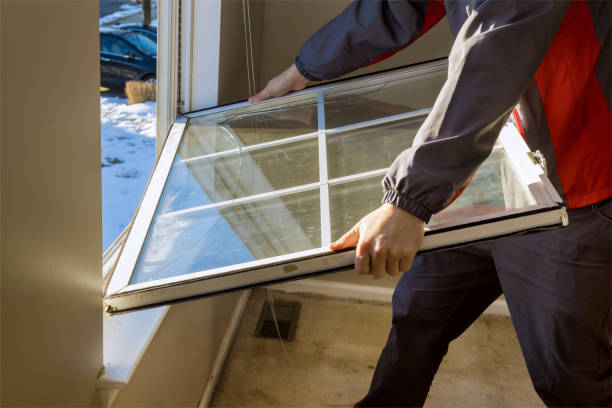Table of Contents
Replacing windows is a major home improvement task that significantly enhances your home’s aesthetic appeal, energy efficiency, and overall value. This guide delves into essential considerations to help you navigate the window replacement process successfully.
1. Assessing the Need for Window Replacement
Recognizing when to replace your windows is crucial. Signs that it’s time for new windows include noticeable drafts, visible damage, condensation buildup between glass panes, and increasing energy bills. Older windows often lack the insulation properties of newer models, leading to heat loss and higher heating and cooling costs.
2. Choosing the Right Window Style
Selecting the appropriate window style is essential for both functionality and aesthetics. Common styles include double-hung, casement, sliding, bay, and bow windows. Double-hung windows, which feature two operable sashes, are versatile and easy to clean. Casement windows, hinged on one side and opening outward, provide excellent ventilation. Sliding windows, which move horizontally along a track, are ideal for limited spaces. Bay and bow windows add architectural interest by projecting outward, creating a sense of spaciousness inside. Consider the architectural style of your home, your ventilation needs, and your personal preferences when choosing a window style. Consulting with a window specialist can help you make an informed decision.
3. Understanding Window Materials
Windows are available in various materials, each offering distinct advantages. The most common materials are wood, vinyl, aluminum, and fiberglass. Wood windows offer a classic look and excellent insulation but require regular maintenance. Vinyl windows are affordable, energy-efficient, and virtually maintenance-free, making them popular among homeowners. Aluminum windows are durable and resistant to corrosion but are less energy-efficient due to their high thermal conductivity. Fiberglass windows are strong, durable, and energy-efficient, often considered the best all-around option. Understanding the properties of each material can help you select windows that align with your priorities, whether they are aesthetics, durability, maintenance, or energy efficiency.
4. Energy Efficiency and Ratings
Energy-efficient windows can significantly reduce your energy consumption and utility bills. Key features to consider include low-emissivity (Low-E) glass, multiple panes, and gas fills. Low-E glass has a special coating that reflects heat, keeping your home cooler in summer and warmer in winter. Double or triple-pane windows provide better insulation and soundproofing compared to single-pane windows. Inert gas fills, such as argon or krypton, between panes further enhance insulation. Look for windows with the ENERGY STAR label, which certifies that they meet strict energy efficiency guidelines. Understanding these features and their benefits can help you choose windows that provide maximum energy savings and comfort.
5. Selecting a Reputable Window Contractor
A successful window replacement project hinges on selecting a skilled and reputable contractor. Start by asking for recommendations from friends, family, or neighbors. Verify the contractor’s credentials, including licenses, insurance, and certifications. Reading online reviews and checking ratings with the Better Business Bureau can provide additional insights into the contractor’s reliability and workmanship. Make sure to get multiple quotes and ask for a detailed estimate that outlines the cost of materials, labor, and additional fees. A reputable contractor will also offer a warranty on their work and be willing to provide references from previous clients. Taking these steps ensures you hire a contractor who can deliver quality results.
6. Planning Your Budget
Window replacement is a significant investment, so careful budgeting is essential. Start by obtaining estimates from several window contractors to get an idea of the cost range. Factor in the price of materials, labor, and any additional expenses such as permits or disposal of old windows. Be sure to account for energy efficiency upgrades, which may have higher upfront costs but deliver long-term savings. Explore financing options, including home improvement loans or manufacturer financing plans. Some improvements might also qualify for tax credits or rebates. Accurate budgeting allows you to balance initial costs with the long-term benefits of improved energy efficiency and home value.
7. Preparing Your Home for Installation
Proper preparation can streamline the installation process and minimize disruptions. Start by clearing the area around your windows, both inside and outside, removing furniture, window treatments, and decor. Protect your floors and furniture with drop cloths or plastic sheeting. Ensure pets and children are kept away from the work area to ensure safety. If your windows have security systems, disable or remove them temporarily. Communicate with your contractor about any specific requirements and confirm the installation schedule. By preparing your home in advance, you help ensure the installation goes smoothly and efficiently, reducing stress and potential delays.
8. Post-Installation Care and Maintenance
Proper care and maintenance of your new windows are vital to ensure their longevity and performance. Begin by familiarizing yourself with the manufacturer’s care instructions. Regularly inspect your windows for any signs of damage or wear, such as cracks, gaps, or malfunctioning hardware. Clean the glass using a mild detergent and soft cloth to avoid scratches. Lubricate moving parts, such as hinges and tracks, to keep them functioning smoothly. Check the caulking and weatherstripping periodically to maintain a tight seal and prevent drafts. By following these maintenance tips, you can preserve your windows’ appearance and functionality, ensuring they perform well for years to come.
• Conclusion
Embarking on a window replacement project requires careful planning and consideration of various factors, from assessing the need for new windows to post-installation maintenance. By choosing the right window style and materials, ensuring energy efficiency, hiring a reputable contractor, and budgeting wisely, you can achieve the desired outcome and enhance your home’s appeal and comfort. Additionally, proper preparation for installation and ongoing care will help you maximize the lifespan and performance of your new windows. Ultimately, a well-executed window replacement project not only improves your home’s energy efficiency and value but also enhances your living experience, providing a more comfortable and aesthetically pleasing environment.
